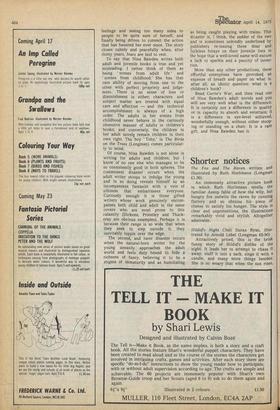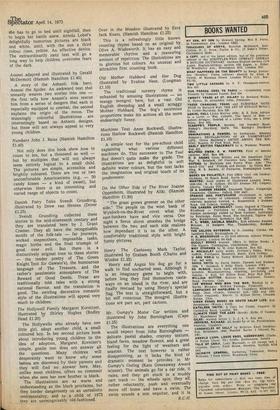Shorter notices
The Fox and The Raven written and illustrated by Ruth Hurlimann (Longman E1.30) An immensely attractive picture book in which Ruth Hurlimann retells the familiar Aesop fable of how the wily, but hungry fox outwits the raven by cunning flattery and so obtains his piece Of cheese to satisfy his hunger. The style is clear and unpretentious, the illustrations remarkably vivid and stylish. Altogether admirable.
Hildid's Night Cheli Duran Ryan, illustrated by Arnold Lobel (Longman £0.90) Attractively priced, 'this is the brisk funny story of Hildid's dislike of the night. It leads her to attempt to chase It away, stuff it into a sack, singe it with a candle, and many more things besides. She is so weary that when the sun rises,
she has to go to bed until nightfall, then to begin her battle anew. Arnolu Lobel's delightfully humorous pictures are black and white, until, with the sun a third colour rises, yellow. An effective device. The extraordinarily zany text will go a long way to help children overcome fears of the dark.
Anansi adapted and illustrated by Gerald McDermott (Hamish Hamilton £1.40)
A story of the Ashanti folk hero, Anansi the Spider. An awkward text that uneasily weaves two stories into one — the first tells how Anansi's sons rescue him from a series of dangers that each is especially equipped to combat, the second explains the origin of the moon. The stunningly colourful illustrations are interestingly based on Ashanti designs, but these will not always appeal to very young children.
Numbers John J. Reiss (Hamish Hamilton E1.40)
Not only does this book show how to count to ten, but a thousand as well — but by multiples that will not always seem entirely logical to a small child. The pictures are simple, accessible and brightly coloured. There are one or two uncomfortable Americanisms (e.g. — 50 candy kisses — a kind of sweet), but otherwise there is an interesting and varied range of objects to count.
Danish Fairy Tales Svendt Grundtvig, illustrated by Drew van Heusen (Dover £1.25)
Svendt Grundtvig collected these stories in the mid-nineteenth century and they are translated here by J. Grant Cramer. They all have the recognisable motifs of the folk-tale — far journeys, wicked stepmothers, impossible tasks, magic births and the final triumph of good over evil. But there is a distinctively original tone to these stories — the tender poetry of The Green Knight /not Sir Gawain's), the humourous language of The Treasure, and the rather's pessimistic atmosphere of The Reward of Good Deeds. These are traditionally told tales with a strong national flavour, and the translation is good. The swirling decorative romantic style of the illustrations will appeal very much to children.
The Hollywell Family Margaret Kornitzer, illustrated by Shirley Hughes (Bodley Head £1.20) The Hollywells who already have one little girl, adopt another child, a small coloured boy. In her second picture book about introducing young children to the idea of adoption, Margaret Kornizer's simple, gentle test does not answer all the questions. Many children will desperately want to know why some babies are disowned y their parents and they will find no answer here. May, unlike most children, offers no comment when she sees her new brother is black.
The illustrations are as warm and understanding as the blurb proclaims, but they border dangerously on an unrealistic sentimentality, and to a child of 1973 they are unrecognisably old-fashioned. Over in the Meadow illustrated by Ezra Jack Keats, (Hamish Hamilton £1.25) This is a refreshingly little known counting rhyme based on an original by Olive A. Wadsworth. It has an easy and memorable ihythm and a reassuring amount of repetition. The illustrations are in glorious hot colours. An unusual and attractive first counting book.
Old Mother Hubbard and Her Dog illustrated by Evaline Ness, (Longman £1.10)
The traditional nursery rhyme is enhanced by amusing illustrations — no mangy mongrel here, but a vast Old English sheepdog and a small scraggy Mother Hubbard. The dog's enormous proportions make his actions all the more endearingly funny.
Machines Text Anne Rockwell, illustrations Harlow Rockwell (Hamish Hamilton £1.10)
A simple text for the pre-school child
explaining what various different machines do. This successor to The Tool Box doesn't quite make the grade. The illustrations are as delightful in soft definite water colours, but the text lacks the imagination and original touch of its predecessor.
On the Other Side of The River Joanne Oppenheim, illustrated by Aliki (Hamish Hamilton £1.30)
"The grass grows greener on the other side." The people on the west bank of Wynlock-on-the-River covet what the east-bankers have and vice versa. One night a fierce storm smashes the bridge between the two and each side realises how dependant it is on the other. A comfortably traditional style with bright funny pictures.
Henry The Castaway Mark Taylor, illustrated by Graham Booth (Chatto and Windus £1.35)
Henry and Angus his dog go for a walk to find uncharted seas. Although it is an imaginary game to begin with, before long they find themselves castaways on an island in the liver, and are finally rescued by using Henry's special flag. The text is straightforward, but a bit self conscious. The mongrel illustrations are part art, part caitoon.
Mr. Gumpy's Motor Car written and illustrated by John Burningham (Cape £1.25)
The illustrations are everything one
would expect from John Burningham — delicate pastel shades, crayony texture, bland faces, meadow flowers, and a great feeling for the light of weathers and seasons. The text however is rather disappointing, as it lacks the kind of dramatic moment he provides in Mr Gumpy's Outing (Kate Greenaway Award winner). The animals go for a car ride, it
rains, and they get stuck in a muddy cart track — the wheels spin, they all, rather reluctantly, push and eventually move off home and have a swim. The swim sounds a non sequitur, and it is.
R.C-H.



































 Previous page
Previous page